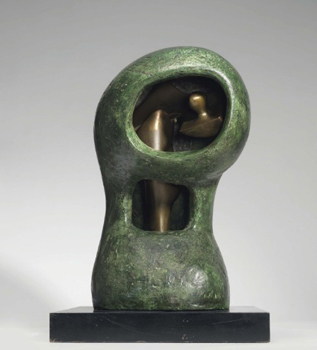Product Description
Otto Heintz / Heintz Art Metal Shop Grand verdigris “Silver Crest” vase c. 1925-30


OTTO HEINTZ, New York
HEINTZ ART METAL SHOP Buffalo, New York
Grand verdigris “Silver Crest” vase c. 1925-30
Bronze with a rich green patina; sterling silver collar and foot
Made by the Heintz Art Metal Shop, Buffalo, NY
Marks: Silver Crest logo with STERLING DECORATED BRONZE, conjoined H A M S in diamond shape, 1080
For further information see: The Arts & Crafts Movement in New York State: 1890s-1920s. Coy L. Ludwig (Hamilton, NY: Gallery Assoc. of NY State, 1983) p. 90.
H: 14 3/4”
The Heinz shop used sterling silver applied as floral ornamentation to bronze. The objects were distinguished by a variety of patinas and machine-shaped bases-very different from the hammered look of most Arts and Crafts metal works. Despite the death of its founder Otto Heinz in 1918 at the age of 41, the company continued and produced a more modern line entitled Silver Crest.
Otto Heintz / Heintz Art Metal Shop Grand verdigris “Silver Crest” vase c. 1925-30
OTTO ECKMANN attr. (1865-1902) Germany
Pair of candlesticks c. 1900
Hand-wrought iron with floral and foliage design
H: 12 ¼” x W: 8 ¼”
Price: $7,475
Otto Eckmann (19 November 1865 – 11 June 1902) was a German painter and graphic artist. He was a prominent member of the “floral” branch of Jugendstil. Otto Eckmann was born in Hamburg, Germany in 1865. He studied at the Kunstgewerbeschule in Hamburg and Nuernberg and at the academy in Munich. In 1894, Eckmann gave up painting (and auctioned off his works) in order to concentrate on applied design. He began producing graphic work for the magazines Pan in 1895 and Jugend in 1896. He also designed book covers for the publishers Cotta, Diederichs, Scherl and Seemann, as well as the logo for the publishing house S. Fischer Verlag. In 1897 he taught ornamental painting at the Unterrichtsanstalt des Königlichen Kunstgewerbemuseums in Berlin. In 1899, he designed the logo for the magazine Die Woche. From 1900 to 1902, Eckmann did graphic work for the Allgemeine Elektrizitätsgesellschaft (AEG). During this time, he designed the fonts Eckmann (in 1900) and Fette Eckmann (in 1902), probably the most common Jugendstil fonts still in use today.
BISMARCK FAMILY CROWN
HOUSE OF KOCH Germany
Chignon crown c. 1900
Moonstones and diamonds set in an elaborate platinum mount, original leather box
The renowned “House of Koch” made this remarkable bejeweled chignon for the Bismarck family of Lauenburg, Germany. It is an early example of exquisite work in platinum and is set with cabochon moonstones and rose cut diamonds. The jewelry firm, known as the “House of Koch” was founded by Robert and Louis Koch in 1879 in Frankfurt, Germany with a branch in Baden-Baden. By 1883, the jewelers had earned the coveted title of Jeweler of the Court of Frankfurt and crafted jewels for many European Royal families. In fact, their jewels were famous across Europe, and their fashionable styles were worn in the courts of several European royals including the King of Italy and the Czar of Russia. By the time Robert Bosch had assumed control of the firm in 1938, the Koch family was forced to “Aryanize” their jewelry house. It was common during the late nineteenth Century for prestigious families to retool old antique heirloom pieces to bring them up to contemporary fashion standards and since this chignon has characteristics of both the 18th and the 19th Century jewelry, it was likely made from older pieces owned by the Bismarck family. The company closed doors in 1987 and jewels from the great time of the House of Koch are very much sought after in today’s antique jewelry market.
